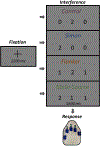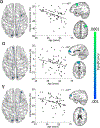Altered age-related alpha and gamma prefrontal-occipital connectivity serving distinct cognitive interference variants
- PMID: 37659656
- PMCID: PMC10545948
- DOI: 10.1016/j.neuroimage.2023.120351
Altered age-related alpha and gamma prefrontal-occipital connectivity serving distinct cognitive interference variants
Abstract
The presence of conflicting stimuli adversely affects behavioral outcomes, which could either be at the level of stimulus (Flanker), response (Simon), or both (Multisource). Briefly, flanker interference involves conflicting stimuli requiring selective attention, Simon interference is caused by an incongruity between the spatial location of the task-relevant stimulus and prepotent motor mapping, and multisource is combination of both. Irrespective of the variant, interference resolution necessitates cognitive control to filter irrelevant information and allocate neural resources to task-related goals. Though previously studied in healthy young adults, the direct quantification of changes in oscillatory activity serving such cognitive control and associated inter-regional interactions in healthy aging are poorly understood. Herein, we used an adapted version of the multisource interference task and magnetoencephalography to investigate age-related alterations in the neural dynamics governing both divergent and convergent cognitive interference in 78 healthy participants (age range: 20-66 years). We identified weaker alpha connectivity between bilateral visual and right dorsolateral prefrontal cortices (DLPFC) and left dorsomedial prefrontal cortices (dmPFC), as well as weaker gamma connectivity between bilateral occipital regions and the right dmPFC during flanker interference with advancing age. Further, an age-related decrease in gamma power was observed in the left cerebellum and parietal region for Simon and differential interference effects (i.e., flanker-Simon), respectively. Moreover, the superadditivity model showed decreased gamma power in the right temporoparietal junction (TPJ) with increasing age. Overall, our findings suggest age-related declines in the engagement of top-down attentional control secondary to reduced alpha and gamma coupling between prefrontal and occipital cortices.
Keywords: aging; functional connectivity; magnetoencephalography; multisource interference task; superadditivity.
Copyright © 2023. Published by Elsevier Inc.
Conflict of interest statement
Declaration of Competing Interest The authors of this manuscript acknowledge no conflicts of interest, financial or otherwise.
Figures






References
-
- Aisenberg D, Sapir A, Close A, Henik A, d’Avossa G, 2018. Right anterior cerebellum BOLD responses reflect age related changes in Simon task sequential effects. Neuropsychologia 109, 155–164. - PubMed
Publication types
MeSH terms
Grants and funding
LinkOut - more resources
Full Text Sources

